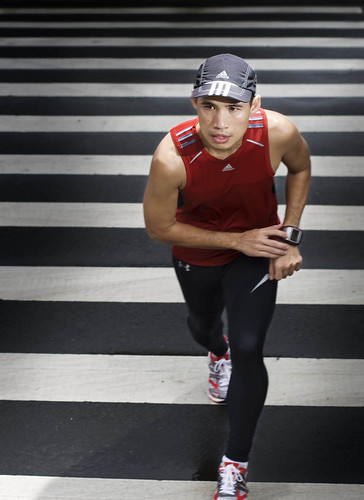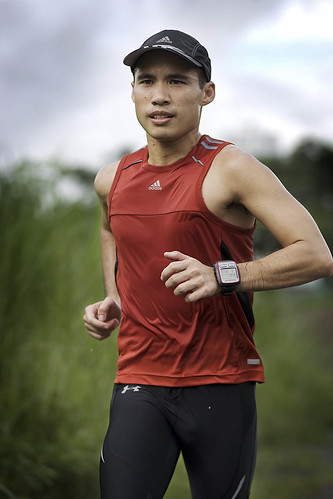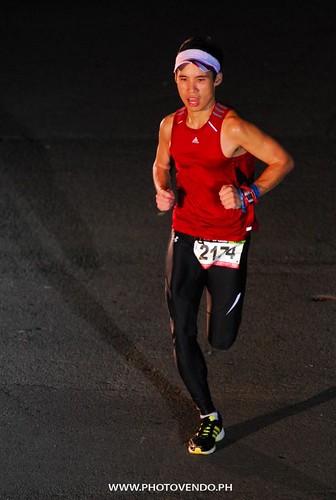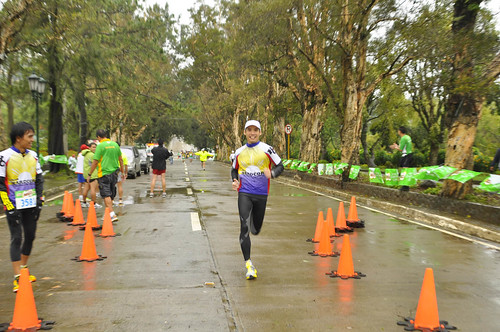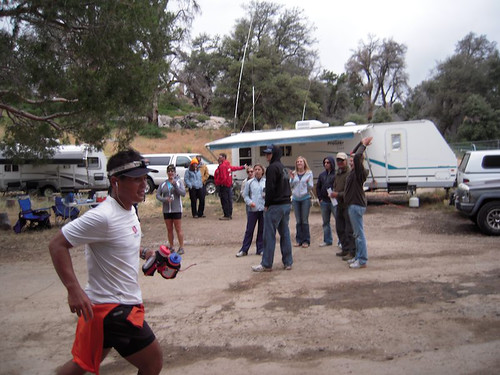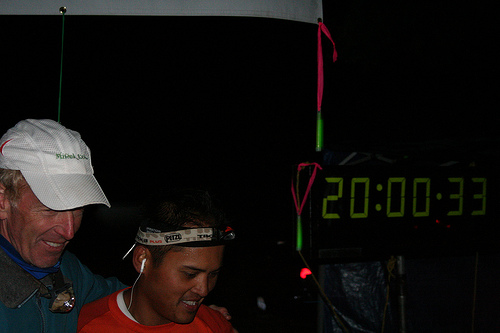Runner’s Interview: Joy Rojas Runs Across the USA
Joy Rojas was the first woman to run across the Philippines in 2005 covering 2000km in 46 days from Mindanao to Luzon. She recently returned from the USA for Takbong Pangarap Trans-USA Run 2009 where she ran 16 states in 196 days, from Los Angeles to New York. She is the first Southeast Asian woman to run across the USA.
– Joy with members of the Philippine American Triathlon Club and Western Union employees at the “finish line” in Central Park –
There are only a handful of local runners who I look up to, not just because of the miles they’ve covered, but because of their pure passion for running; Joy Rojas is certainly in that list. I was fortunate enough to have met her from whom I learned a thing or two about determination, humility, and integrity. Here goes our interview…
Starting point: May 10, 2009, Eagle Rock Plaza, Los Angeles
Ending point: November 22, 2009, Central Park, New York
Total distance ran: 2,761 miles
Ave. distance per day: 26-30 miles
Running days: 113 days.
Rest days: 83
Total # of days for entire trip: 196 days
What made you think of taking on this incredible journey of running across America? How did the idea come about?
After my running partner Mat Macabe and I ran across the Philippines (Davao City to Pagudpud, Ilocos Norte) in 2005, I felt such great happiness and longing to be on the road again. More and more, I really felt that I still had a long run left in me. So after much introspection, I decided that running across the Philippines (which was a dream I carried in my mind and heart for seven years, after running across the Visayas in 1997), shouldn’t be the end of a dream but the start of many others. We thought of running across the US for many reasons: at least 200 people had done it, language shouldn’t be a problem, and with all the Pinoys scattered all over the States, the potential for support was there.
How did you plan your route across the USA?
I read the websites of transcontinental runners and I was drawn to the routes of two runners (Martin Illiot and Jackson Williams) who both recently crossed America. I figured, if they were able to run their routes, then they’re passable. Originally, I wanted to start in San Francisco, because I wanted to cross the Golden Gate Bridge, but contacts were established in Los Angeles, and that’s why we started where we did. The route continued to evolve as we ran. There was the request to include Washington DC, so states like West Virginia, Virginia, and Maryland were added into the mix. And when we had to be in Denver for an event hosted by our sponsor Western Union, we were advised by friends to enter Colorado by way of Arizona, not Utah as originally planned, because it was a slightly shorter (and less hilly) route.
– Joy and Mat running in the fog in Fairview Heights, IL –
You were running over a marathon daily for nearly six months, how did this feel physically and emotionally? Amazingly, I felt good in California, Nevada, Utah, Arizona, and Colorado. I was running at my best: although my legs felt tired at the end of the day, I experienced no lactic acid (thank you, SportsAde!), and I had more blisters on my lips than my feet due to windburn. Once I got the injury in Kansas (excruciating pain in my left pelvis which was misdiagnosed as a pulled muscle and bursitis along the way; an MRI in St. Louis, MO, revealed it was a stress fracture), I slowed down considerably to the point that I would walk 30 miles for many days. The month-and-a-half break plus the daily doses of calcium and vitamin D helped, but because we had very little time left to finish before snowfall and Thanksgiving hit New York, I had to run almost 26 miles daily from October 7 to November 22.
Getting back into high-mileage runs after weeks of relative inactivity was painful. My right leg swelled up like the Michelin man’s, and my pelvis was so sore, I limped and held on to Mat for support at the end of the day. From Ohio to New York, the soles of my feet were so sore, I felt like I wasn’t wearing shoes when I was running. And for the first time in my years of running, I felt such incredible pain pulsating to the tips of my toes, I was afraid to remove my shoes and socks after each run because I worried about what my feet would look like. To this day, my feet are still sore and my left hip hurts a bit during short, easy runs. I think it’ll be a while before I can run the way I used to. But that’s okay; I demanded so much from my body, it deserves the rest.
For most of the run, I was okay emotionally, but I have to admit, the last stretch from St. Louis, MO to Central Park, NY was very stressful. When you’re running slow because you’re in pain and the days are becoming shorter (it’s dark by 4:30 pm), you can really feel the pressure to finish. I don’t know how many times I cried before, during, and after a day of running, but thank goodness for Mat, Danny Titus (the American photographer who acted as our coordinator during the run), and for family and friends who called or texted to cheer me on and assure me of their prayers.
Did you run alone most of the time? What do you think of during your long, solitary runs?
Yes, I ran mostly by myself. Mat underwent open heart surgery (mitral valve replacement) in March 2008, and although he ran many parts of the route (at an easy pace) with me, Danny and I prevented him from tiring himself. My thoughts were random and varied: I thought about what I wanted to eat at the end of the day, made up stories about how various debris (from cellphones to clothes and toys) ended up on the side of the road, and recalled family, friends, and situations that we had just been through.
I also prayed a lot. Once, when I was in such pain in Missouri, my mom texted me from out of the blue and told me about all the priests and church friends she recruited to pray for us. She also told me to say the rosary while I ran, and I did, chanting Our Fathers and Hail Marys under my breath, and counting them with my fingers. I’m not religious but I have to say it had such a calming effect on me. Before I knew it, I had recited several cycles and we had reached our destination for the day.
– “Best travel companions: Whether I was running at my best or my worst, Mat Macabe and Danny Titus never left my side. These two true gentlemen were the height of patience, understanding and encouragement.” –
What was the highlight of the entire run?
At first I thought it was watching the landscapes and colors changing right before our eyes, but for Mat and I, it was America’s big heart that proved the highlight of the run. Everybody was just so kind to us; strangers took us into their homes, gave us water, honked their horns and pumped their fists into the air to cheer us on. This was our first time ever in the US and we never expected Americans to be this friendly or supportive.
What was the most challenging portion for you?
Physically, it was running from Beltsville to Baltimore. We were on the fringes of Typhoon Ida, but even then, it felt like we were at the center of the storm. Imagine running—or in my case, walking—under 5°C rains, 23 mph headwinds, and on a very busy highway with a shoulder that comes and goes.
You suffered a stress fracture midway through the run. How did you deal with it? Was quitting ever an option?
Thankfully, we caught it in time where rest, calcium and vitamin D were the only things needed to make it heal. Had I continued, my doctor warned me, I would have broken my hip. Danny drove us back to the west coast to recuperate because he felt that being surrounded by friends would hasten my healing.
There was never a moment when I thought of quitting. For one thing, this was just too rare an opportunity, I knew we would never be able to do it again. For another thing, we had come so far! We covered 2/3 of America, New York was already within reach, so it would be such a waste to end it abruptly. More importantly, so many people’s lives were affected by my decision to run across the US, I really felt it would be such a great disservice to Mat, Danny, our sponsors, family and friends, if I decided to quit because I didn’t have the patience to sit it out for a month and a half and heal.
– Joy running on the dry part of Lake Mead, Nevada –
What gadgets did you use to track your mileage and ensure you covered an accurate distance?
Danny Titus used a road atlas, maps of each state, Google Maps, and a GPS to track our mileage. Before Danny officially joined us in Arizona, Mat and I relied on an atlas, state maps, and a GPS. Two Filipino friends from Los Angeles who were familiar with US roads and had Internet access, Dr. Jing Mercado and Bert Jaurigue, served as our advisers while we were still in the West Coast. They would call daily to check on us, and Bert, in particular would call several times a day, often while I was still running, to ask of our whereabouts. He and his wife Ces literally went the extra mile for us: they crewed for us from Barstow to Yermo Road, CA (30.7 miles) and from Mesquite, NV to the Shivwitz Indian Reservation, UT (31.4 miles). They were also present in our events in Las Vegas, NV and Denver, CO
I’m pretty old school when it comes to gadgets, so the only gadgets I used were a runner’s watch, iPod and cellphone. To get perspective on how far I ran, I relied on road signs (those green and white ones that report the mileage from town to town), mile markers, and updates from Danny, who advanced 3 miles at a time after I caught up with him. Sometimes, there would be no mile markers along the way, and at first it felt weird not knowing how much I already covered. Eventually, I kind of liked not knowing; it felt liberating to just run. But of course, Danny and Mat were always there to remind me.
You called this run “Takbong Pangarap.” Is this your biggest dream? Are there any more dream runs you would like to achieve?
– Catching the changing of the leaves in Bainbridge, OH –
Our friends in the States, people we met because of this project, are already dreaming up other runs for us, but Mat says he doesn’t want me to put any more runs together because it hurts him to see me struggle, both physically and emotionally. Personally, I say never say never, but for now, what I really want to do is go back to work, and spend time with family and friends. And go on some short and easy runs.






